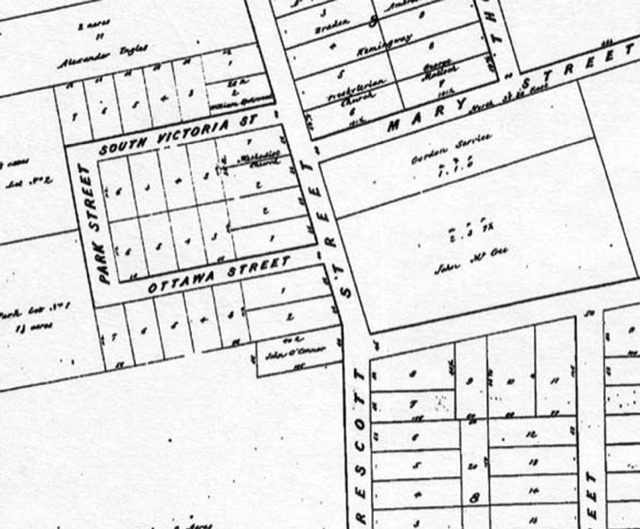In 1857, the Village of Kemptville separated from the Township of Oxford-on-Rideau, becoming an Incorporated Village with its own municipal government. But the financial arrangements under the new regime did not suit William Bottum, known as Squire Bottum around the township, and he used his influence as a scion of an important Loyalist family to have his property detached from Kemptville and restored to Oxford. So, on July 24, 1858, another Act was passed to change the boundaries of Kemptville. The new boundary line on the west wove in and out around land that Bottum had previously sold to the Anglican Church. All of Bottum’s land south of the river (what is now Riverside Park, the site of the hospital, etc., was now removed from Kemptville. The boundary line ran along the line of today’s Reuben Street, from the Legion to the Curling Club, meaning all of Riverside Park now lay outside the village limits.
Before around 1840, there had been virtually no development of the land south of the river. Aside from an early school that is said to have opened in the 1820’s where the CIBC Bank now stands, and continued until the 1840’s, the Prescott Street area was largely grazing land for cattle, with a narrow track that disappeared into the bush as it wound towards the far-off town of Prescott. But with the arrival of the train service on the south side of town in 1854, more and more business and residential development moved across the river.
The layout of the streets was quite different then. The section of Reuben that runs from the Curling Club to Prescott Street today was known in the 1860’s as South Victoria Street, and, as the illustration shows, formed a block with Park Street and Ottawa Street, neither of which exist today. Note the Methodist (now United) and Presbyterian Churches marked on the map. The area that is now Riverside Park was never settled and remained a green space just outside the village limits, until the Kemptville Agricultural Society was founded and leased part of the property between the river and the village in 1887. It was not until 1902 that the park was bought by the Village of Kemptville and became the location for many events and sporting activities. Reuben Street was then a dead end, with very few buildings on the north side, and none at all on the south. One major difference with today’s street was a side street leading from Reuben to the South Branch. It was the main entry to the mill located on the river bank, and the dam that crossed the river. Asa Clothier owned a house on the corner of this street and Reuben, and Lewis Grant had a building between Reuben and the river. At the end of Reuben, where No. 19 is today, stood a house owned by John Maley, one of four brothers who owned a general merchants store on Clothier Street. Reuben Street was named after Reuben Clothier, a member of Kemptville’s founding family. By 1917, the south side of the street remained undeveloped. The site of the CIBC bank on Prescott was then the home of Dr. G. D. Gordon, a fine two-storey brick building, with stables and later sheds, where the CIBC parking lot is now. The lane that still runs from Reuben behind the buildings on Prescott appears on a map of 1917.
Beyond the laneway, there were no other buildings on that side of the street. The houses that stand there today date mostly from after the Second World War, all the way around to the Legion building, which was built in 1957. Before that, the Great War Veterans met at the Armoury until the reorganised Legion moved into the new Legion Hall across the road.
The Armoury was opened in July, 1914, built of brick and standing three storeys tall. When it was first opened, it was described as follows: “It has three stories, basement, main floor and gallery. The basement contains a shooting gallery and furnaces; the main floor is cement and has sufficient space to drill two companies [of militia] while at one end there are two armouries for the arms and accouterments of the company. The gallery consists of balcony and three meeting rooms. The building is lighted with electricity and heated by hot air”.
In 1968, the building was taken over as the new station of the Kemptville Fire Department until 2009, when it became the home of the Navy League of Canada, Kemptville Branch 338 Defiant.
The north side of Reuben has seen a great deal of change over the decades. Number 15 appears on the 1917 map, and the new Post Office on the corner of Prescott was opened in 1915, and a movie theatre began showing silent movies some time before 1920. It was owned by the Bowen family, and later carried on by Paul Bedell, who went bankrupt. It was run then by Richmond Theatre Ltd., until 1929, when it finally closed and the building was turned into law offices. But, in 1949, Vincent Kelly, from Ottawa, bought the premises and reopened a movie theatre there. The Empress Theatre provided movies to the people of North Grenville until Christmas, 1959, when it finally closed for lack of business. The build ing was bought by Ralph Raina, who renovated it into a storage space and later a store. In 1967, Raina sold the site to the Crown, and the Empress was finally demolished to make way for the present Post Office building, which replaced the one at the corner of Prescott Street in 1970.
It took a long time for Reuben Street to develop an identity, and, aside from providing access to the mill on the river, it served no vital function until after Riverside Park was absorbed into the Village of Kemptville. From that time on, it became an important route to the Park, and later to the cinema and then the Post Office. Today, it is often busy with traffic going to and from events, people collecting their mail, or sending it off from the Post Office, or visiting the CIBC parking lot. It is long story that seems only to grow in the telling.








